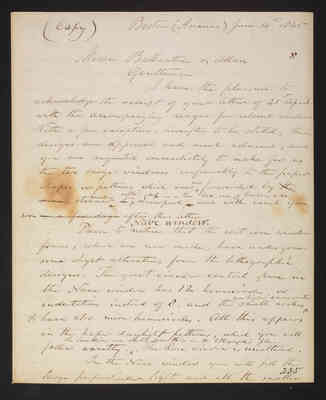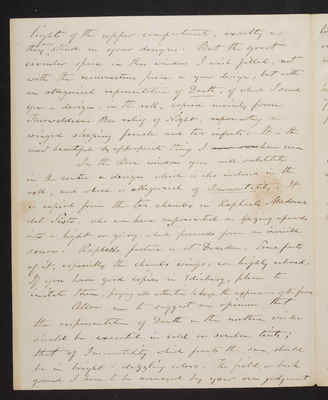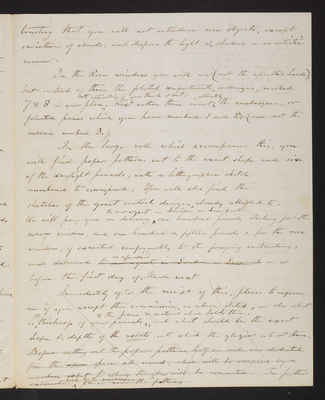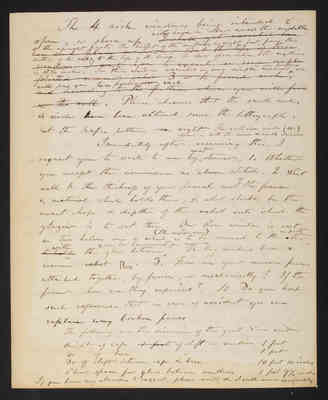Pages
1845-06-14 Bigelow Chapel Stained Glass: Jacob Bigelow to Ballantine & Allan (page 1)
(copy)
Boston (America)
Messrs Ballantine & Allan
Gentlemen
I have the pleasure to acknowledge the receipt of your letter of with the accompanying designs for colored windows. With a few exceptions, hereafter to be stated, these designs are approved and much admired, and you are requested immediately to make for us the two large windows conformably to the paper shapes or patterns which are ^now forwarded by the Cambria steamer ^rolled up in a tin box, care of Harnden & Co, Liverpool, and will reach you soon in a few days after this letter.
Nave Window.
Please to notice that the cast iron window frames, which are now made, have undergone some slight alterations from the lithographic designs. The great circular central space in the Nave window has 12 hemicircles, or indentations instead of 8, and the small arches ^are higher & more acute & have also more hemicircles. All this appears in the paper daylight patterns, which you will follow exactly. ^The mullions are shorter now than in the lithograph plan. The Rose window is unaltered.
In the Nave window you will fill the large perpendicular lights and all the smaller
235
1845-06-14 Bigelow Chapel Stained Glass: Jacob Bigelow to Ballantine & Allan (page 2)
lights of the upper compartments, exactly as they ^now stand in your designs. But the great circular space in this window I wish filled, not with the resurrection piece in your design, but with an allegorical representation of Death, of which I send you a design, in the roll, copied mainly from Thorwaldsens Bas relief of Night, representing a winged sleeping female and two infants. It is the most beautiful & appropriate thing I ever saw have seen.
In the Rose window you will substitute in the centre a design which is also inclosed in the roll, and which is allegorical of Immortality. It is copied from the two cherubs in Raphaels Madonna del Sisto, who are here represented as gazing upwards into a light or glory, which proceeds from an invisible source. Raphaels picture is at Dresden. Some parts of it, especially the cherub wings, are highly colored. If you have good copies in Edinburgh, please to imitate them, paying all attention to keep the expression of the faces.
Allow me to suggest an opinion that the representation of Death in the northern window should be executed in cold or sombre tints; that of Immortality which fronts the sun, should be in bright & dazzling colors. The field, or back ground I leave to be managed by your own judgement
1845-06-14 Bigelow Chapel Stained Glass: Jacob Bigelow to Ballantine & Allan (page 3)
trusting that you will not introduce new objects, except variations of clouds, and disperse the light & shadows in an artistic manner.
In the Rose window you will use (not the apostles heads) but instead of them the foliated compartments, or designs, marked 7 & 8 in your plan^ both alternately if you think it best.^ Next within these insert ^alternately the arabesques, or foliated panes which you have marked 1 and 2, (and not the mosaic marked 3.)
In the large roll which accompanies this, you will find paper patterns cut to the exact shape and size of the daylight pannels [sic], with a lithographic sketch numbered to correspond. You will also find the sketches of the great central design, already alluded to. We will pay you on delivery ^ to our agent in London or Liverpool ^ one hundred pounds sterling for the nave window, and one hundred & fifteen pounds s. for the rose window, if executed conformably to the foregoing instructions, and delivered to our agent in London or Liverpool as aforesaid on or before the first day of March next.
[this next paragraph has been crossed out in pencil]
Immediately after the receipt of this, please to inform me if you accept the commission, as above stated, -- also what is ^the thickness of your pannels ^ in the frame & material which holds them., ^ and what should be the exact shape & depth of the rebats into which the glazier is to set them. Before cutting out the paper patterns, half an inch was deducted from the space all round, which will be occupied by a wooden rebat to which the glass will be cemented. For further explanations ^ made by the mechanic, please read the patterns
1845-06-14 Bigelow Chapel Stained Glass: Jacob Bigelow to Ballantine & Allan (page 4)
The 4 aisle windows being intended to open, or shove up, ^ will have a bar across the middle I shall get executed here of the upright part. The height of the mullions is eight feet, from the in send plain manner; But the tops of these bottom of the caps to the top of the bases. The clear space between the mullions windows. I wish you to execute in some simple is 18 1/2 inches. For these windows executed in some simple manner ^ as you propose we folicated manner value 3 or 4 pound each. will pay you ten pounds each. and according to the patterns which you will find in the roll. Please observe that the small arches & circles have been altered since the lithograph, but the paper patterns are right. The cast iron circle (10.) ^ appears in both the nave & aisle windows.
Immediately after receiving this, I request you to write to me by ^next steamer, 1. Whether you accept the commission as above stated. 2. What will be the thickness of your pannels and ^f the frame & material which holds them, & what should be the exact shape & depth of the rebat into which the glazier is to set them. Our Rose window is cast in two halves one of which ^(the inside one) is to be screwed to the other ^in parts to hold with the glass between ^& can be unscrewed for repairs. The long windows have a common rebat [sketch]. 3. How are your mosaic pieces attached together, by fusion, or mechanically? If the former, how are they repaired? 4. Do you keep such references that in case of accident you can replace any broken panes.
The following are the dimensions of the great Nave window
Height of cap & foot of shaft or mullion 1 foot Do [ditto] of base 1 foot Do [ditto] of shaft between cap & base 10 feet 10 inches Clear space for glass between mullions 1 foot 9 1/2 inches
If you have any alterations to suggest, please write & I will answer immediately





 Follow Us on Instagram
Follow Us on Instagram 